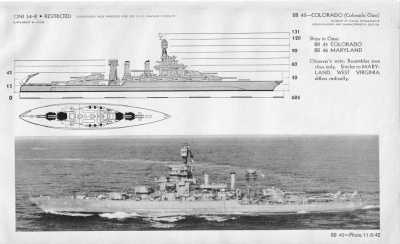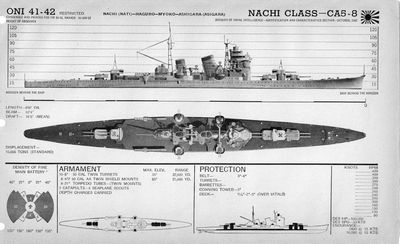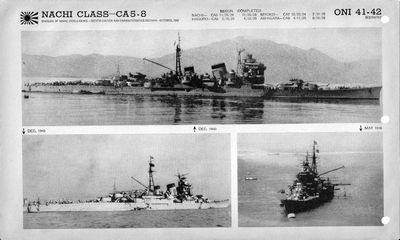Ships of World War Two
Battleships, Aircraft Carriers, Cruisers, Destroyers, etc.
By Stephen Sherman, June, 2007. Updated Oct. 16, 2013.
Using the pictures from a 1943 U.S. Naval Recognition Manual as a base, this section covers the major naval powers of the war: United States, United Kingdom, and Germany. As the manual was designed specifically for recognition, it includes plan views of classes of warships, not individual ships (surface ships only, no submarines). Thus, all the ships presented here are lead ships of their class.
In the precise prose of the era, "The basic principle of Surface Vessel recognition as with aircraft is familiarity with the total form of the object observed. The true character of a ship is not determined by a single feature or features, but by the familiarity we may have with the total mass of the hull and the superstructure, when viewed from great distances. ... The salient recognition characteristics are shown in their simplest form by silhouettes. ... In ship recognition, the use of beam, or side view silhouette, is by far the most important. If the beam silhouette is thoroughly known, the ship can be recognized from either the surface or the air."
"Preceding each group of vessels of each nation represented in this manual is a chart of these simplified silhouettes representing a vessel of each class. These are arranged at the same scale for ease of comparison with each other and with other ships in the same class in other navies. Large instructional charts of these simplified silhouettes are being prepared and will be distributed in the near future."
Each ship (or class of ship) has two pages in the manual. The first page typically shows a profile view and a top view, and below a diagram of the density of fire from its main battery, armament, protection, and speed, illustrated in the thumbnail of the Japanese cruiser Nachi at left. The second page typically shows two or three photographs of the ship.
Below is a random page from the 1943 Naval Recognition Manual, which includes plan views, profiles, and photographs of the ships.
United States Navy
This is not an online version of Samuel Eliot Morison's History of United States Naval Operations in World War Two, merely a summary and some images of ships.United Kingdom - the Royal Navy
This is not an online history of all British Naval Operations in World War Two, merely a summary and some images of ships.
Shipwrecks
Some of the most famous shipwrecks of World War Two are off Guadalcanal, in the famed "Iron Bottom Sound." In one terrible night, the Battle of Savo Island, August 8-9, 1942, the United States Navy lost three cruisers and the Australians one, while the Japanese ships were only damaged that night. Altogether almost 50 Japanese and American ships were sunk in WW2 naval battles lie off Guadalcanal, from other engagements in the same area.
Another spot filled with shipwrecks is Truk Lagoon, site of a major Japanese naval base that was heavily bombed by the Americans. Many warships and merchantmen ("maru") still lie there, in relatively shallow waters that have made Truk Lagoon a favorite destination for scuba divers.
This site is devoted the the thirteen shipwrecks in Kwajalein.
Ship plans
Check out each ship page in this section, as the schematic diagrams are, in effect, gross-level plans.
Here is a sample, the USS Colorado:

For every ship discussed here, there is a comparable ship plan.
Ships sunk
During the course of WWII, over 1,500 ships were sunk: in the Pacific, by German submarines in the North Atlantic, the French Fleet at Toulon, on the Murmansk run.
The oceanographer, Bob Ballard, who had devoted life to underwater research, has even located and photographed the U.S.S. Yorktown, destroyed during the battle of Midway in 1942 and now resting 17,000 feet below the waves. His book "Graveyards of the Pacific" offers exactly what readers expect, including a Japanese torpedo at Pearl Harbor.
Sources: Public domain Dictionary of American Naval Fighting Ships
and scans from my father's 1943 Naval Recognition Manual


